In the always-growing pursuit of sustainability, industries worldwide are making strides to adopt eco-friendly practices, particularly in the realm of water treatment. Traditional water treatment methods have long been associated with environmental challenges and economic burdens.
As the global demand for water rises and environmental concerns intensify, the need for sustainable water treatment has become more critical than ever. In this context, the journey towards adopting eco-friendly water treatment practices takes center stage. Let’s explore some of the challenges faced by conventional water treatment, explore emerging technologies, and highlight the role of innovative solutions in enhancing the sustainability of water treatment practices.
Challenges in Conventional Water Treatment
Conventional water treatment methods, while effective, come with their fair share of challenges. The heavy reliance on chemicals, high energy consumption, and the generation of waste by-products contribute to environmental degradation and economic strain. The quest for sustainable alternatives prompts us to reevaluate our approach to water treatment, seeking solutions that mitigate these challenges and lead to more responsible water management.
Emerging Technologies in Water Treatment
If we explore emerging technologies a bit, we encounter innovative solutions that promise to revolutionize water treatment practices. We can take the PTSA sensor as a case study and an example of progress in monitoring water quality, most notably in cooling towers.
The PTSA sensor, or p-toluenesulfonamide sensor, represents a cutting-edge technology that actively measures trace chemicals in cooling tower water. Its introduction marks a significant advancement in the continuous monitoring of water treatment parameters. By ensuring the precise and real-time control of inhibitor levels, the PTSA sensor plays a crucial role in preventing scale formation, corrosion, and microbial growth in cooling tower systems.
What sets the PTSA sensor apart are its unique features. With a minimum detection limit under 1 part per billion (ppb) and a resolution of 0.01 ppb, this sensor provides unparalleled accuracy in measuring trace chemicals. Its advanced optical filtering capability prevents turbidity interference, ensuring reliable data even in challenging conditions. The flat sensing design allows for flexible, non-specific in-line orientation, facilitating easy integration into existing systems.
The PTSA sensor is not only technologically advanced, but also environmentally conscious. Its contribution to sustainable water treatment lies in its ability to optimize inhibitor levels, ultimately reducing chemical usage and maintenance expenses. This aligns with the broader goal of minimizing the environmental impact associated with traditional water treatment methods.
Renewable Energy in Water Treatment
As we explore sustainable water treatment options, the integration of renewable energy sources emerges as another crucial aspect. The shift towards solar and wind power in water treatment facilities showcases a commitment to reducing carbon footprints. By harnessing the power of nature, these facilities not only enhance their sustainability but also contribute to the larger goal of transitioning towards cleaner energy alternatives.
Through the incorporation of renewable energy, water treatment plants can reduce their dependency on traditional power sources, thereby mitigating environmental impact. The synergistic approach of utilizing sustainable technologies alongside renewable energy signifies a comprehensive strategy for eco-friendly water treatment practices.
Also read: How IoT Applications for StormWater Management
Smart Water Management Systems
The advent of smart water management systems further amplifies the prospects of sustainable water treatment. These systems, equipped with sensors, data analytics, and automation, optimize water treatment processes with unprecedented efficiency. By constantly monitoring and adjusting water treatment parameters in real-time, smart systems ensure resource conservation and operational cost-effectiveness.
If we take our earlier example of the PTSA sensor, its integration into smart water management systems enhances their capabilities. The continuous monitoring of PTSA levels allows for dynamic adjustments, ensuring that inhibitor concentrations are precisely maintained. This not only prevents issues like scale formation and corrosion but also minimizes the need for reactive interventions, contributing to sustainable and proactive water management.
The Role of Green Chemistry in Water Treatment
Green chemistry principles offer yet another avenue for sustainable water treatment. By prioritizing environmentally friendly chemicals and processes, green chemistry aligns with the broader objective of reducing the ecological footprint of water treatment practices. This approach not only ensures the effectiveness of water treatment but also minimizes the impact on aquatic ecosystems.
If we make another example in our case study of the PTSA sensor, we’ll see it actively contributes to precise water treatment control, and is inherently part of this green chemistry movement. Its role in optimizing inhibitor levels echoes the principles of environmentally conscious practices, further solidifying its place in the landscape of sustainable water treatment technologies.
Water Reuse and Recycling
One of the hallmarks of sustainable water management is the emphasis on water reuse and recycling. As we confront the challenges of water scarcity, treating and reusing water becomes paramount. Technologies and practices that facilitate the safe reuse of treated water contribute not only to environmental conservation but also to the efficient utilization of this precious resource.
Back to our example of the PTSA sensor – it here plays a dual role. By ensuring effective water treatment in cooling towers, it indirectly contributes to the quality of water available for potential reuse. Its ability to prevent scale formation and corrosion prolongs the lifespan of cooling tower systems, reducing the need for frequent replacements and minimizing the environmental impact associated with equipment disposal.
Final Words
The landscape of sustainable water treatment is evolving, driven by a commitment to environmental responsibility and resource conservation. The challenges posed by conventional water treatment methods are being met with numerous innovative solutions, and we mentioned the PTSA sensor as just one example. This advanced technology, with its precise measurements and environmental consciousness, exemplifies the potential for a sustainable future in water management.
As we embrace renewable energy, smart water management systems, and green chemistry principles, the ongoing efforts to transform water treatment into a more sustainable and eco-friendly process continues. By integrating new technologies and principles into our water treatment practices, we not only address the challenges of today, but also pave the way for a resilient and sustainable water future!










Leave a comment